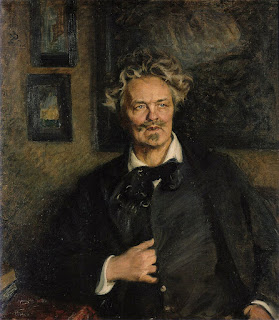Working with Alwyn
Following on from an earlier blog post, I asked Philip Lane, well known for his reconstructions of film scores, what it was like to work on Alwyn's scores...
How did you first become involved with the film scores of William Alwyn? And what can you remember about working with them?
PL: The first Alwyn films I worked on were The Crimson Pirate and A night to remember for which I had no material other than
the soundtrack. As with all projects the first job is to extract which passages
of the film score are strong enough musically to stand up meaningfully without
the pictures.
In the case of Crimson Pirate, the record company concerned,
Silva Screen, chose the extracts they wanted and put them on a cassette for me.
The result, recorded in Prague, I played to Mary Alwyn (aka composer, Doreen Carwithen) at her home in
Blythburgh.
 |
| The garden at William and Mary's home in Blythburgh. Painted by William Alwyn. |
She was suitably pleased and encouraging in her responses, and
subsequently recommended me to Brian Couzens of Chandos for his forthcoming
Movie series to which I have contributed some dozen or so discs by now,
including three Alwyn, (soon to be four).
Presumably some reconstructions are easier than others? What challenges do you face? What have you found most satisfying?
PL: Material comes in three forms - nothing, sketches and
full scores. Obviously with the latter, the job is to pick the strongest music
and often link cues together so that one is not left with a series of very
short pieces of music. With sketches the same requirements apply, but with the
additional job of orchestration, based on what can be heard on the soundtrack.
Just the soundtrack presents obviously the most time-consuming and difficult
obstacles to overcome, but also, sometimes, is the most artistically fulfilling
option. Some scores do not lend themselves to ’suites’, but instead a single
movement suffices incorporating the main theme or themes in the form of an
overture, or portrait of the leading character or the basic characteristic of
the plot. The Million Pound Note was a case in point where I took the waltz
theme and created an unashamedly one movement, Der Rosenkavalieresque
‘indulgence’ that several critics particularly picked up on !
Sometimes just the Main Titles (suitably adapted) is a
satisfactory outcome.
Reconstructions are often needed with film scores, because, so often, the original was destroyed, as you mentioned in a previous article. Have you had any lucky finds?
PL: In the case of The ship that died of shame, I
found it in an attic in Oxfordshire among the papers of Dock Mathieson, Ealing’s
last Musical Director, just before his widow was about to put it out with the weekly rubbish,
as it was not filed away but lost in a pile of what she deemed to be virgin
sheets of manuscript paper!
Favourite Alwyn projects?
PL: The most challenging projects are sometimes the most
enjoyable as were two Disney films, (Swiss Family Robinson and In search of the castaways) which I remembered from my childhood, and so it was quite humbling
to be dipping my toes, as it were, in something so ingrained.
Working on the scores, in whatever capacity, one is
constantly aware of an extraordinary musical mind at work. The detail and
involvement shown endlessly when shortcuts and basic working would have been
the easier route, just make one admire Alwyn more and more. I am so pleased to
have been involved in this project in bringing his work to the aural forefront,
rather than just supporting other artists’ endeavours in the area of film. I
hope he would have been pleased with our efforts on his behalf, even though he
would probably, like so many of his contemporaries in the field, have been
utterly bewildered that such a project was ever envisaged at all.
Many thanks to Philip Lane.



Comments
Post a Comment
Please feel free to ask questions or comment. Comments will be visible after moderation. Thank you.